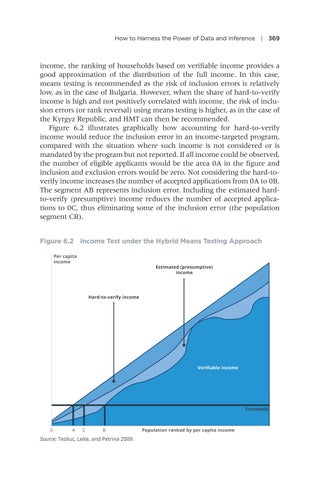How to Harness the Power of Data and Inference | 369
income, the ranking of households based on verifiable income provides a good approximation of the distribution of the full income. In this case, means testing is recommended as the risk of inclusion errors is relatively low, as in the case of Bulgaria. However, when the share of hard-to-verify income is high and not positively correlated with income, the risk of inclusion errors (or rank reversal) using means testing is higher, as in the case of the Kyrgyz Republic, and HMT can then be recommended. Figure 6.2 illustrates graphically how accounting for hard-to-verify income would reduce the inclusion error in an income-targeted program, compared with the situation where such income is not considered or is mandated by the program but not reported. If all income could be observed, the number of eligible applicants would be the area 0A in the figure and inclusion and exclusion errors would be zero. Not considering the hard-toverify income increases the number of accepted applications from 0A to 0B. The segment AB represents inclusion error. Including the estimated hardto-verify (presumptive) income reduces the number of accepted applications to 0C, thus eliminating some of the inclusion error (the population segment CB). Figure 6.2 Income Test under the Hybrid Means Testing Approach Per capita income
Estimated (presumptive) income
Hard-to-verify income
Verifiable income
Threshold
0
A
C
B
Source: Tesliuc, Leite, and Petrina 2009.
Population ranked by per capita income


